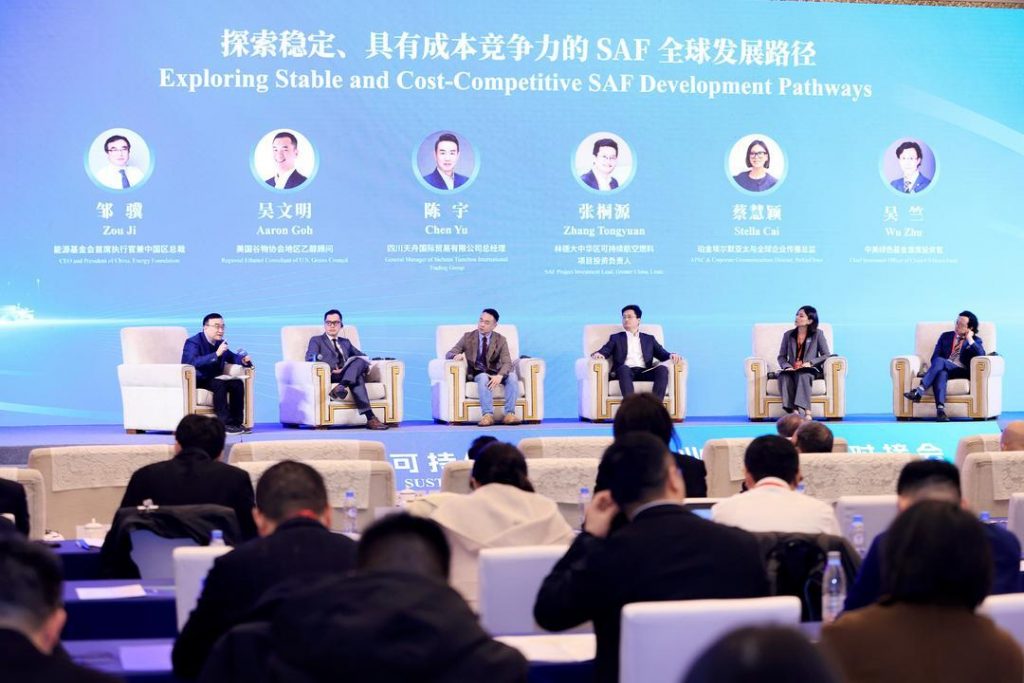Last week, the U.S. Grains Council’s (USGC’s) office in Beijing, China organized a set of exploratory meetings aimed at assessing demand for Synthetic Aviation Fuel (SAF). USGC Director in China Manuel Sanchez led the team that included USGC Program Manager Ellie Yan and USGC Regional Ethanol Consultant Aaron Goh.
“Our goal on this program was to update Chinese stakeholders on U.S. practices on biofuels, especially fuel ethanol for SAF, share the Council’s approach and achievements in promoting the use of biofuels for carbon reduction and provide reference values for Chinese government agencies to set industry standards and participate in international collaboration in the future,” Sanchez said.
The highlight of the mission was a SAF Partnership Conference held in Chengdu, organized by the U.S.-China Business Council (USCBC) and Sichuan Provincial Government that featured panel discussions and presentations about the current state of SAF and the pathways of stable and cost-competitive SAF.
Speaking during a panel session on feedstock diversification, Goh presented an overview on the potential role of alcohol to jet (ATJ) technology in supplementing China’s SAF production goals. While hydroprocessed esters and fatty acids (HEFA) fuel remains the primary pathway for SAF adoption, the Council believes there is value in discussing ethanol as an ATJ feedstock and staff sought to raise this awareness and propagate future discussions during the conference.
Later that day, the team met with SAF-focused staff from China National Aviation Fuel Southwest Company and Sichuan Airlines to better understand their goals for SAF production and use, industry standards and how the U.S. industry can support the international transportation sector’s goals of reducing carbon emissions.
The mission ended with a meeting with a local SAF producer that is building a production site in western China with a capacity of 500,000 tons of SAF per year. Goh gave a detailed presentation on the ATJ process and its commercial viability and the open discussion that followed demonstrated their willingness to explore alternative pathways to meet China’s SAF aspirations.
“We see great value in the partnership with USCBC and forming part of the vital event with guests representing the industry, policy, technology and investment in the SAF value chain. As the world’s two largest civil aviation markets, China and the United States can help countries achieve complementary advantages in the production, transportation and use of SAF and enhance global SAF supply capacity and efficiency,” Sanchez said.
“China currently consumes 40 million tons of jet fuel per year. Under the Fly Net Zero initiative adopted by the International Air Transport Association in 2021, the global aviation industry is committed to achieving zero carbon emissions by 2050, and the Council is ready to support China’s aviation industry in its decarbonization goals in the years to come.”
Learn more about the Council’s work in China here.
About The U.S. Grains Council
The U.S. Grains Council develops export markets for U.S. barley, corn, sorghum and related products including distiller’s dried grains with solubles (DDGS) and ethanol. With full-time presence in 28 locations, the Council operates programs in more than 50 countries and the European Union. The Council believes exports are vital to global economic development and to U.S. agriculture’s profitability. Detailed information about the Council and its programs is online at www.grains.org.

